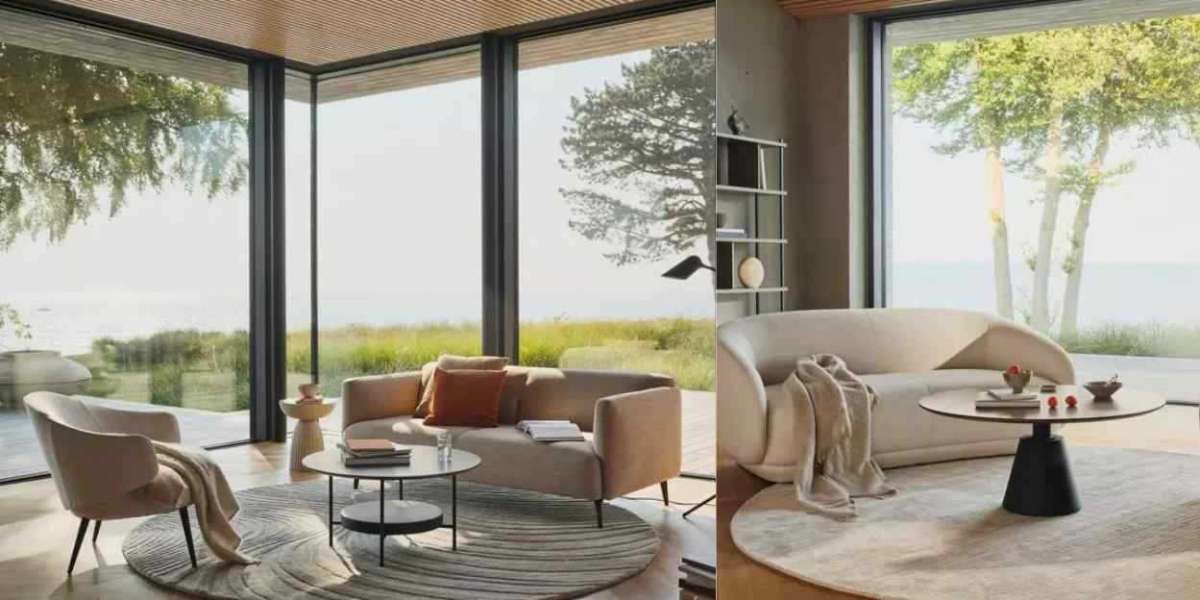Your living room is the heart of your home—a place for family time, entertaining guests, or relaxing solo. The right furniture enhances both form and function; it grounds the room and reflects your personal taste. Well-designed pieces can elevate a simple space into a stylish sanctuary.
Design Aesthetic: The Scandinavian Influence
Inspired by brands like BoConcept, Scandinavian design principles balance simplicity, functionality, and comfort:
- Clean lines and minimal ornamentation
- Use of natural materials: oak, ash, leather
- Emphasis on neutral tones with warm accents
- Multifunctionality: modular sofas, built-in storage
- A focus on light and airy spaces
These principles create a timeless aesthetic that’s flexible and versatile.
Choosing Core Furniture Pieces
Sofa Seating
- A large, modular sectional or a well-proportioned three‑seater with chaise provides flexibility and comfort.
- Upholstery options: leather for durability; soft wool or high-performance polyester for cozier appeal.
- Consider sofa beds for occasional guests.
Coffee Tables Side Tables
- Materials: solid wood, glass-topped steel, or marble.
- Shapes: Round tables soften edges; rectangles complement linear furniture.
- Dual-purpose designs: tables with storage underneath or adjustable heights.
Media and Storage Units
- Wall-mounted units maintain openness.
- Modular shelves adapt to evolving needs.
- Concealed storage helps control visual clutter.
Accent Chairs Ottomans
- A well-chosen armchair or leisure chair adds character.
- Ottomans offer extra seating, footrest options, or hidden storage.
Rugs Textiles
- Layer a large neutral rug with textiles in natural fibers: wool, jute, cotton.
- Add cushions and throws in muted colors—earth tones, pastels, or warm grays.
Layout Space Planning
Zone Definition
Define seating, media, reading, or play zones using area rugs and furniture grouping.
Maintain 3–4 ft of walkable paths around zones to ensure good flow.
Scaled Furniture
Ensure circulation—leave 10–15 in (25–38 cm) between a sofa and coffee table, 18–20 in between sofa and TV.
Flexibility
Modular sofas and nesting tables adapt to different uses: game nights, parties, or solitude.
Materials Sustainability
Wood
Scandinavian designs highlight oak, ash, birch – light-colored woods that show grain and wear beautifully.
Textiles
Choose durable, stain-resistant fabrics. Pure wool rugs are eco-friendly and long-lasting. Leather ages gracefully, while recycled polyester reduces waste.
Eco-conscious Options
- Furniture with FSC-certified wood
- VOC-free finishes
- Brands using hiding toxins and renewable resources
Color Palette Light
Base Palette
Stick to whites, off-whites, creams, pale grays—they anchor your space.
Accent Tones
Introduce warm neutrals like camel or beige or gentle hues like sage green and dusty rose to complement your furnishings.
Natural Light
- Use sheer curtains or blinds.
- Add mirror(s) to amplify light.
- Layer light: overhead fixtures, floor lamps, table lamps, spot lighting.
Accessories Finishing Touches
- Artwork: Choose framed, minimal prints or bold single pieces.
- Plants: Tall indoor greenery (e.g., fiddle-leaf fig, rubber plant) softens hard edges and freshens air.
- Textiles: Throws, cushions, and poufs in tactile materials (knits, bouclé, suede) add texture.
- Mixed metals: Combine muted brass, matte black, warm steel for visual interest.
Top Tips to Pull It All Together
- Start with essentials: sofa, coffee table, rug—center your layout there.
- Work top-down: choose lighting, then textiles, art, and accessories.
- Scale mindfully: a compact modular sofa maximizes space in smaller rooms.
- Make it personal: add meaningful items—photographs, travel souvenirs, heirlooms.
- Keep surfaces tidy: use baskets and trays to organize minimalistically.
- Rotate accents with seasonal textiles and pillows.
Inspiring Living Room Styles
Modern Minimalist
- Monochrome palette — black, white, gray
- Sleek, low-profile sofa
- Floating media unit + geometric rug
- Sparse accessories—one or two key art pieces
Cozy Scandinavian
- Warm neutral tones + wooden frames
- Chunky-knit throws, patterned cushions
- Wicker basket for plush blankets
- Leather armchair for reading nook
Urban Industrial
- Leather sofa + black‑metal coffee table
- Exposed brick or concrete backdrop
- Edison bulb floor lamp + distressed wood credenza
- Rug to unify softened warmth
Case Study: A BoConcept‑Inspired Layout
- Sectional sofa in light gray with removable covers
- Round oak coffee table with recessed tray surface
- Low wall-mounted media console in white lacquer
- Slim-line reading lamp, oak-legged occasional chair
- Floor rug: 8×10 ft pale wool
- Accessories: abstract art in muted tones, tall fiddle-leaf plant, brass candlesticks
This combination exemplifies how minimalist form, natural materials, and functional design can coexist beautifully.
Furniture Selection Checklist
Category | Key Considerations |
Sofa | Size, modularity, upholstery durability |
Seating | Armchair ergonomics, ottoman versatility |
Tables | Height, shape, storage underneath |
Storage Units | Modularity, open vs closed display |
Rugs | Size, fiber, non-slip backing |
Lighting | Layers, temperature, design harmony |
Accessories | Texture, personal value, proportional scale |
Budgeting Investment Tips
- Invest in your sofa—it's the room's anchor.
- Save on smaller items like side tables or lamps.
- DIY or upcycle: repaint or reupholster existing pieces to refresh your space.
- Seasonal swaps: supervised updates to pillows or art allow fresh look with minimal cost.
Common Pitfalls to Avoid
- Choosing an oversized sofa that overwhelms your space
- Pushing all furniture flush against walls—hinders social zones and flow
- Overloading accessories—missing intentional minimalism
- Forgetting soft lighting for ambiance—focusing only on overhead fixtures
Future Trends in 2025+
- Curved forms: Softer, rounded designs aiding cozier interaction
- Biophilic design: Emphasizing plant-rich interiors and natural finishes
- Smart furniture integration: Hidden wireless charging, discreet speakers
- Multi‑generational spaces: Universal comfort with ottomans and adjustable lighting
- Sustainable materials: Increasing use of recycled wood, reclaimed metals, and low-impact fibers
Final Thoughts
Living‑room furniture design is more than choosing pretty pieces—it’s about creating a holistic experience. When design, materials, scale, light, and personalization are thoughtfully combined, your living room becomes a sanctuary—stylish, functional, and uniquely yours.




